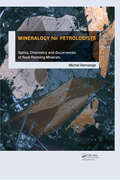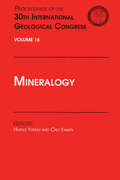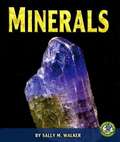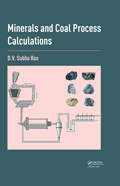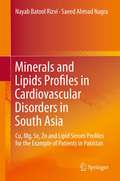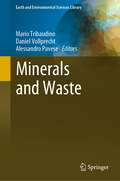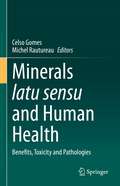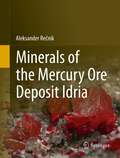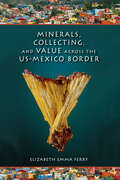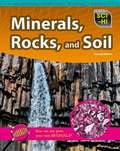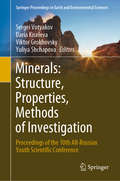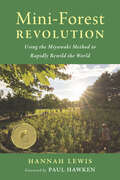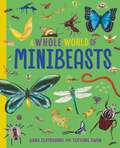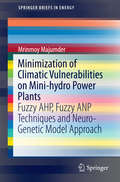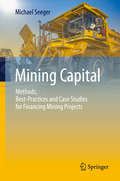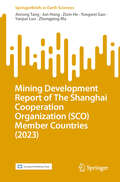- Table View
- List View
Mineralogie: Eine Einführung in die spezielle Mineralogie, Petrologie und Lagerstättenkunde
by Martin Okrusch Hartwig E. FrimmelDieses Buch bietet eine vergleichsweise umfangreiche Einführung in die spezielle Mineralogie, Petrologie, Geochemie und Lagerstättenkunde. Es entwickelte sich aus dem ursprünglich von Siegfried Matthes konzipierten, dann von Martin Okrusch weitergeführten Lehrbuch, das mittlerweile zu einem bewährten Klassiker geworden ist. Die vorliegende, mittlerweile 10. Neuauflage unterscheidet sich von den Vorgängern durch eine komplette Überarbeitung von Text und Abbildungen, die stark von der Handschrift Hartwig Frimmels, dem Nachfolger von Martin Okrusch, geprägt ist. Dabei aber blieben die Autoren der Grundidee eines für den geowissenschaftlichen Unterricht an der Universität zugeschnittenen Lehrbuchs treu, welches die langjährige Erfahrung der Autoren in Lehre und Forschung widerspiegelt. Zahlreiche Hinweise auf die wirtschaftliche Bedeutung von Mineralen, Gesteinen und Erzen werden dem wieder erstarkten gesellschaftlichen Interesse an der zukünftigen Versorgung mit mineralischen Rohstoffen gerecht. Die gegenüber anderen, insbesondere Internetquellen deutlich tiefer gehende Bearbeitung von Themen ermöglicht es, ein Verständnis für die komplexen Zusammenhänge zwischen Geomaterialien und geologischen Prozessen – sei es auf der Erde oder auf anderen Himmelskörpern – aus moderner Sicht zu entwickeln. Dabei wird aber nicht auf essentielle Grundlagen verzichtet, auch wenn sie schon vor Jahrzehnten entwickelt worden sind. Nicht zuletzt wegen seiner umfangreichen Bebilderung ist das Buch wertvolles Handwerkszeug für interessierte Mineraliensammler.
Mineralogy for Petrologists: Optics, Chemistry and Occurrences of Rock-Forming Minerals
by Michel Andre DemangeThis book provides a categorized and visualized overview and presents microscopic observations, systematic mineralogy, chemistry, geology, stability, paragenesis, occurrence and use in petrology of 137 minerals. Structural formula calculations are included in the appendix. Consists of a set of book and downloadable resources for students and practically-oriented researchers and professionals in geology, geological, mining, and mineral resources engineering who need a reference of mineralogy, applied to petrology.The downloadable resources contain 384 color plates with mineral microscopic visuals under various circumstances.
Mineralogy: An Introduction to Minerals, Rocks, and Mineral Deposits (Springer Textbooks in Earth Sciences, Geography and Environment)
by Martin Okrusch Hartwig E. FrimmelThis book presents a translation and update of the classic German textbook of Mineralogy and Petrology that has been published for decades. It provides an introduction to mineralogy, petrology, and geochemistry, discussing the principles of mineralogy, including crystallography, chemical bonding, and physical properties, and the genesis of minerals in a didactic and understandable way. Illustrated with numerous figures and tables, it also features several sections dedicated to the genesis of mineral resources. The textbook reflects the authors’ many years of experience and is ideal for use in lectures on mineralogy and petrology.
Mineralogy: Proceedings of the 30th International Geological Congress, Volume 16
by Huang Yunhui Cao YawenThis book is a collection of papers presented in the 30th International Geological Congress, held in Beijing, on mineralogy. The papers deal with topics on fine structures and crystallographic orientations in biogenic magnetite and thermodynamic properties of minerals.
Minerals
by Hans-Rudolf Wenk Andrei BulakhThis introduction to mineralogy for undergraduate and graduate students in geology and materials science has been designed for a semester course. Covering all aspects of mineralogy in an integrated way, it links mineral properties with broader geological processes, and conveys their economic importance throughout the text. Handy reference tables and a glossary of terms make this study an indispensable guide for the next generation of mineralogy students.
Minerals
by Wenk Hans-Rudolf Andrey BulakhThe new edition of this popular textbook, once again, provides an indispensable guide for the next generation of mineralogists. Designed for use on one- or two-semester courses, this second edition has been thoughtfully reorganised, making it more accessible to students, whilst still being suitable for an advanced mineralogy course. Additions include expanded introductions to many chapters, a new introductory chapter on crystal chemistry, revised figures, and an extended plates section containing beautiful colour photographs. Text boxes include historical background and case studies to engage students, and end-of-chapter questions help them reinforce concepts. With new online resources to support learning and teaching, including laboratory exercises, PowerPoint slides, useful web links and mineral identification tables, this is a sound investment for students in the fields of geology, materials science and environmental science, and a valuable reference for researchers, collectors and anyone interested in minerals.
Minerals (Early Bird Earth Science)
by Sally M. WalkerA mineral is a substance found in nature. Minerals are solid. They are not alive, like plants and animals are. Earth has more than 3,500 different kinds of minerals.
Minerals and Allied Natural Resources and their Sustainable Development
by Sanjib Chandra Sarkar Mihir DebNonrenewable natural resources - metallic and non-metallic minerals, industrial rocks and energy resources (both organic and inorganic), have been treated in a holistic manner in this book, including two important resources (soil and water), not commonly covered in most books on this topic. For the uninitiated reader, an introductory chapter looks into some basic definitions as well as nature and characteristics of mineral deposits followed by a chapter on the different crustal processes that produce the various ore deposits in the endogenous and exogenous environments. The strength of the book lies in its critical treatment of the genetic processes of the mineral deposits, their classification and the geodynamic context of metallogeny, and coverage of sustainable development of mineral deposits with special reference to various socio-economic as well as regulatory and environmental issues that face the Indian mining industry today. The text is punctuated with examples of Indian deposits, balanced with classical deposits around the world, to cater to the interests of Indian students and the international readership. This is a book for advanced undergraduate and post-graduate students of Geology, Environmental Sciences and Natural Resource Management.
Minerals and Coal Process Calculations
by D.V. Subba RaoThe aim of process calculations is to evaluate the performance of minerals and coal processing operations in terms of efficiency of the operation, grade of the final products and recovery of the required constituents. To meet these requirements, in-depth detailed calculations are illustrated in this book. This book is designed to cover all the process calculations. The method and/or steps in process calculations have been described by taking numerical examples. Process calculations illustrated in a simple and self explanatory manner based on two basic material balance equations will allow the reader to understand the contents thoroughly. Inclusion of elaborate process calculations in every chapter is the highlight of this book. This book is unique and devoted entirely to the process calculations with sufficient explanation of the nature of the calculations. This book will prove useful to all: from student to teacher, operator to engineer, researcher to designer, and process personnel to plant auditors concerned with minerals and coal processing.
Minerals and Lipids Profiles in Cardiovascular Disorders in South Asia
by Nayab Batool Rizvi Saeed Ahmad NagraThis book correlates different minerals and lipids serum profiles with the prevalence of cardiovascular disorders in South Asian countries with special emphasis on Pakistan. Cardiovascular disorders (CVD, e. g. coronary heart diseases, hypertension, rheumatic heart disease, angina, heart failure and deep vein thrombosis) show significantly increasing rates in South Asian countries like Pakistan and have become a major health problem. Nevertheless, the data on any aspect of cardiovascular problems still is scanty. The serum profiles of different minerals (copper, magnesium, zinc, selenium) and lipids are analyzed in detail. The presented data will thus lead to a better understanding of the problem and help to provide possible solutions, which can be achieved, e. g. through ameliorated minerals profiles in the daily diet. These results can help develop better dietary management strategies in the prevention and treatment of CVD.
Minerals and Waste (Earth and Environmental Sciences Library)
by Mario Tribaudino Daniel Vollprecht Alessandro PaveseIn the field of waste disposal, recovery, and recycling, industrial residues from ceramic and mining activities are just an assemblage of minerals. So is municipal waste, after removing the organic part in incinerators or after long-time disposal. In almost every case, a natural counterpart is present. Applying what is known from natural systems on waste assemblages is the key to predicting their fate, at a short and long time, and suggesting the best for high-temperature recycling.This book aims to bring the Earth Science community to the edge of waste management, offering background information, the basics of high and low-temperature geochemistry involved, and an overview of waste investigation connected to minerals. This book also addresses mineral tailings, incinerator bottom, fly ashes, metal slags, ceramic industry residue, and eventually sanitary issues.The primary readership will be graduate students and professionals in geological and environmental fields.
Minerals as Advanced Materials II
by S V KrivovichevThis book is a collection of papers that are devoted to various aspects of interactions between mineralogy and material sciences. It will include reviews, perspective papers and original research papers on mineral nanostructures, biomineralization, micro- and nanoporous mineral phases as functional materials, physical and optical properties of minerals, etc. Many important materials that dominate modern technological development were known to mineralogists for hundreds of years, though their properties were not fully recognized. Mineralogy, on the other hand, needs new impacts for the further development in the line of modern scientific achievements such as bio- and nanotechnologies as well as by the understanding of a deep role that information plays in the formation of natural structures and definition of natural processes. It is the idea of this series of books to provide an arena for interdisciplinary discussion on minerals as advanced materials.
Minerals latu sensu and Human Health: Benefits, Toxicity and Pathologies
by Michel Rautureau Celso GomesThis volume provides a comprehensive academic review of both positive and negative effects of minerals on human health and quality of life. The book adopts the concept of mineral latu sensu (mineral l.s.), which encompasses a broad spectrum of natural, inorganic, solid, and crystalline, of natural and inorganic chemical elements (metals and metalloids), of modified natural minerals, of biominerals, and of syntetic minerals, all products that branch across the disciplines of earth, soil, environmental, materials, nutrition, and health sciences. Using this broad framework, the authors are able to provide a multidisciplinary assessment on many types of minerals which can be essential, beneficial and hazardous to human health, covering applications in medical geology, medical hydrology or balneotherapy, pharmacology, chemistry, nutrition, and biophysics. The book performs historical analyses of the uses of minerals for therapeutic and cosmetic purposes to better understand current trends and developments in mineral research and human health. The book will be of interest to students, public health officials, environmental agencies and researchers from various disciplines, as well as scientific societies and organizations focusing on medical geology, health resort medicine (crenotherapy, hydrotherapy and climatotherapy), and on pharmaceutical, cosmetic and biomedical applications.
Minerals of the mercury ore deposit Idria
by Aleksander RecnikThe present work is the first comprehensive study of mineralogy of the world's second largest mercury mine Idria. In the first chapter the readers are acquainted with the history of mining and its relation to mineralogy. Mineralogy is explained in terms of geological processes that were active during the formation of the ore deposit. Among these, hydrocarbons present in the host rocks play a very important role during crystallization. The central part of the book is dedicated to the main mineral of the ore deposit, cinnabar. It occurs in a variety of crystal forms, of which the most special are lateral interpenetration twins. The book is written for a broad readership, and will be interesting for geologists, mineralogist and crystallographers, as well as for those interested in the history of mineral collecting in Idria.
Minerals, Collecting, and Value across the US-Mexico Border
by Elizabeth Emma Ferry“A jewel to those interested in ore mining, mineral collecting and mineralogy, or the anthropology of value.” —American EthnologistAnthropologist Elizabeth Emma Ferry traces the movement of minerals as they circulate from Mexican mines to markets, museums, and private collections on both sides of the United States-Mexico border. She describes how and why these byproducts of ore mining come to be valued by people in various walks of life as scientific specimens, religious offerings, works of art, and luxury collectibles. The story of mineral exploration and trade defines a variegated transnational space, shedding new light on the complex relationship between these two countries—and on the process of making value itself.“A novel contribution to the anthropology of natural resources.” —Journal of Latin American and Caribbean Anthropology“Highly recommended.” —Choice
Minerals, Rocks, and Soil (Sci-Hi: Earth and Space Science)
by Barbara Davis‘Minerals, Rocks, and Soil’ shows you how minerals, soil, and rocks form. You will learn where minerals can be found and how to identify them. You will find out all about the different types of rocks and what they can be used for. You will discover which types of soil are best for plants to grow in. So, come on a fantastic journey into the world of minerals, rocks, and soil! Sci-Hi is an engaging, comprehensive, and visually stimulating series that takes learning science core curriculum to a whole new level!
Minerals: Proceedings of the 10th All-Russian Youth Scientific Conference (Springer Proceedings in Earth and Environmental Sciences)
by Sergei Votyakov Daria Kiseleva Viktor Grokhovsky Yuliya ShchapovaThis book is devoted to the most relevant issues in crystal chemistry and mineral typomorphism; the structure, physico-chemical and technological properties of minerals; and the computational modeling of mineral structure and properties. Considerable attention is paid to the latest advances in and applications of physical methods of investigation for mineral structure and composition, in particular, X-Ray diffraction, spectroscopic (optical, vibrational, ESR, Moessbauer, etc.) and microscopic (SEM, TEM, AFM, etc.) studies, as well as chemical and isotopic analysis methods. The current research trends in space and planetary mineralogy (meteorites, regolites, tektites) are also discussed. Though specifically intended for the specialist earth and planetary science readership, the book will be of interest to a broad range of scientists. It gathers the proceedings of the Tenth All-Russian Youth Scientific Conference “Minerals: structure, properties, methods of investigation.” Jointly organized by the Institute of Geology and Geochemistry, the Institute of Mineralogy (Urals Branch of the Russian Academy of Sciences) and Ural Federal University, the event was held in Ekaterinburg, Russia, on May 27–June 1, 2019.
Mines of Clear Creek County
by Ben M. DuganIn 1859, "Pikes Peak or bust!" spread across America and brought men and their families from all over to the Kansas goldfields seeking a new beginning. Thousands came to Clear Creek and Gilpin Counties and eventually settled all of Colorado. The mining communities of Idaho Springs, Georgetown, Empire, Silver Plume, Dumont, and Lawson all exist because of the pursuit of gold and silver. Gold was initially easy to get to, but in time, underground mineral development was necessary. New technologies and the Industrial Revolution made mining easier, but there was still work to be done to establish local fire departments, churches, schools, and governments.
Mini-Forest Revolution: Using the Miyawaki Method to Rapidly Rewild the World
by Hannah Lewis*2023 Nautilus Book Award Gold Medal Winner: Green, Restorative Practices /Sustainability&“Hannah Lewis describes a gift to a despairing world. . . . There may be no single climate solution that has a greater breadth of benefits than mini-forests. . . [and] can be done by everyone everywhere.&”—Paul Hawken, from the forewordFor readers who enjoyed Finding the Mother Tree and The Hidden Life of Trees comes the first-ever book about a movement to restore biodiversity in our cities and towns by transforming empty lots, backyards, and degraded land into mini-forests. Author Hannah Lewis is the forest maker turning asphalt into ecosystems to save the planet and she wants everyone to know they can do it too.In Mini-Forest Revolution, Lewis presents the Miyawaki Method, a unique approach to reforestation devised by Japanese botanist Akira Miyawaki. She explains how tiny forests as small as six parking spaces grow quickly and are much more biodiverse than those planted by conventional methods. She explores the science behind why Miyawaki-style mini-forests work and the myriad environmental benefits, including: cooling urban heat islands, establishing wildlife corridors, building soil health, sequestering carbon, creating pollinator habitats, and more.Today, the Miyawaki Method is witnessing a worldwide surge in popularity. Lewis shares the stories of mini-forests that have sprung up across the globe and the people who are planting them―from a young forest along the concrete alley of the Beirut River in Lebanon, to a backyard forest planted by tiny-forest champion Shubhendu Sharma in India.This inspiring book offers a revolutionary approach to planting trees and a truly accessible solution to the climate crisis that can be implemented by communities, classrooms, cities, clubs, and families everywhere. &“Lewis simplifies the science of planting trees in a manner that produces the maximum benefit.&”—The Associated Press
Minibeasts (A Whole World of... #3)
by Anna ClaybourneGet lost in the diverse and bustling world of minibeasts - with more to explore than you ever imagined!A Whole World of Minibeasts presents the stunning breadth of minibeast varieties that roam Earth, including everything from insects to arachnids, slugs, snails and worms to millipedes and teeny, tiny tardigrades. Who is related to whom? Which type swim or fly or hop? Which have the coolest camouflage, and which have the most legs (over 1,000!)? This book has the answers and so many more facts filling the beautifully illustrated pages.A Whole World of is a book series looking at the extraordinary diversity of life on Earth - the defining features and evolutionary branches - and encourages readers age 7 and up to consider why it is important to maintain biodiversity. Written by award-winning author, Anna Claybourne, with artwork by award-winning illustrator, Yekyung Kwon.Books in the series:A Whole World of Mammals/A Whole World of Prehistoric Life/A Whole World of Minibeasts/A Whole World of Birds/A Whole World of Rocks and Minerals/A Whole World of Plants and Fungi
Minibeasts (Animal Stats)
by Simon AbbottDo you think you're a minibeast expert? Get the stats on the BIGGEST, the smallest, the fastest, the LOUDEST and much more!Packed with fascinating facts, stats and data, curious kids will be amazed to learn about the millions of minibeast species that share our planet, as well as habitats, ecosystems and life cycles, super senses and how bugs are so important to a healthy planet. Simon Abbott's fun characters draw in curious minds by answering the science and numeracy questions kids want to know, with the super-impressive answers found in nature!The Animal Stats series features accessible text paired with bright, colourful artwork, ideal for readers aged 6+, and includes a creature quiz at the back of the book to test their knowledge. Other titles in the series include Animals, Sea Life and Dinosaurs.
Minimally Processed Refrigerated Fruits and Vegetables
by Fatih Yildiz Robert C. WileyThe first edition of Minimally Processed and Refrigerated Fruits and Vegetables, edited by Robert C. Wiley and Fatih Yildiz, was published in 1994. At the time of publication, this was a new concept and was well-received by the scientific community. Minimally processed foods are whole plant tissues (the identity of the plant tissue is recognized by consumers), which may contain active enzymes, live tissues, and plant cells. These are some of the basics for the healthy food design. The overall function of these foods is to provide convenient (ready-to-serve, ready-to cook, free of any pesticides and contaminants),like-fresh products for food service and retail consumers. Minimally Processed and Refrigerated Foods (MPR) have been popular in many countries. The following are some of the advantages offered by MPR produce foods: 1. Ease of portion control in the food service industry 2. Lower transportation cost (all inedible portions of the produce are removed prior to transportation) 3. No waste is generated at the point of consumption 4. Utilization and recycling of the waste is much easier 5. Value-added new fruit and vegetable products and meal development is possible and easy 6. No requirement is needed for phytosanitary control during trade 7-No glycation end products formation during processing, 8. Degree of food processing is minimized for optimal health of human, the processing plant for MPR produce, which is not addressed in any other books on this topic, will be described in this second edition. Also, comparison of minimal processing technologies with other technologies was explained in the first publication and will be updated in this second edition. During the last 200 years the purpose of food processing was a-safety(sterilization, Pasteurization,1804 Nicholas Apert,Pasteur 1867), and b-prevention of deficiency diseases(Enrichments),but MPR foods provides a two new dimensions to food processing ; a-Prevention of chronic diseases(bioactive compounds) and b-Optimum health (functional foods,Superfoods,Neutraceuticals, and Medical foods) for human.
Minimization of Climatic Vulnerabilities on Mini-hydro Power Plants
by Mrinmoy MajumderThis Brief presents the multi criteria decision making (MCDM) techniques like Fuzzy Analytical Hierarchy Process (AHP) and Fuzzy Analytical Network Process (ANP) to find out the importance of the influencing factors to develop the Climatic Vulnerability Index (CVI) that will represent the vulnerability of the Hydro-Power Plant (HPP) to climatic abnormalities. The cognitive ability of neuro-genetic modeling is applied to minimize CVI so that the conditions required to reduce the effect of climate change on HPP can be identified. The results from the study are found to be encouraging. The scarcity and pollution potential of conventional sources of energy has enforced scientists worldwide to look for efficient, flexible, cost effective but reliable alternative energy resources. Among many available options the energy extracted from water was found to be the least expensive, most flexible and moderately reliable renewable energy source which has the potential to replace the dependency on conventional fuels.
Mining Capital: Methods, Best-Practices and Case Studies for Financing Mining Projects
by Michael SeegerMining is a capital-intensive industry, and involves long lead times to develop projects that demand a structured approach, from mine exploration to exit. This book provides mine developers, investors, owners, shareholders, and mineral policymakers a comprehensive game plan to raise capital for the development of new mining projects or to bolster operational mines. The author, an experienced mining capital consultant, shows how mine developers and mine owners can secure capital in any phase of the commodity price cycle, at any site, and at any project stage. The book follows a proven and structured approach that enables mine developers and owners to successfully raise capital for their projects. With the aid of case studies and practical methods, the reader will learn the essentials on topics ranging from developing and marketing a business case for investment, to the types and sources of mining capital for different project stages, as well as the structure and significance of due diligence. The author presents actual mining projects and their funding plans, transaction structures and term sheets for capital. The mining projects discussed represent various project stages, commodities, and parts of the globe, offering a comprehensive reference guide for mine developers, investors and promoters alike.
Mining Development Report of The Shanghai Cooperation Organization (SpringerBriefs in Earth Sciences)
by Jun Hong Jinrong Tang Zixin He Yongwei Gao Yanjun Luo Zhongping MaThis is the first research report on mining development in the SCO member countries conducted by a Chinese research institute. It focuses on the economic development, mineral resources endowment and current status of mining development, mining investment environment, and cooperation in geosciences and mining industry between China and other SCO member countries. The aim of this book is to promote the practical cooperation in geoscience and mining in the SCO and to build a closer community of destiny for the development of mining industry in the SCO. The translation was done with the help of artificial intelligence. The present version has been revised technically and linguistically by the authors in collaboration with a professional translator.

